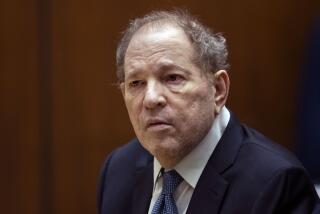Priests Sign Up for Exorcism 101
The Roman Catholic Church is facing a shortage you may not have heard about: qualified exorcists.
And so, on Thursday about 100 priests stood, prayed for protection, then sat down to begin an eight-week study of how to distinguish and fight demonic possession.
The course at Rome’s prestigious Regina Apostolorum Pontifical Athenaeum, represents the first time a Vatican- sanctioned course in exorcism is being offered at this level.
In Italy, the number of official exorcists has soared during the last 20 years to between 300 and 400, church officials say. But they aren’t enough to handle the avalanche of requests for help from hundreds of tormented people who believe they are possessed. In the United States, the shortage is even more acute.
Only a small percentage of those in distress are judged to be in need of an exorcism, and learning how to tell the difference between demonic possession and other psychological or physical traumas is the main goal of the priestly students taking the course at the Regina Apostolorum.
“When you’re dealing with a reality like the devil,” said 39-year-old Father Clement Machado of Canada, “you can’t just learn the theoretical. You need the pragmatic experience.... It’s such uncharted territory.”
Italy’s most famous exorcist, Father Gabriele Amorth, is not participating in the program but was full of praise for it.
“It’s very positive,” Amorth, 80, said in an interview this week. “I hope it will increase the number of exorcists.” Without a doubt, he said, it will increase interest in the ancient and oft- maligned ritual.
Exorcism -- the use of prayer to rid a person or place of the devil or demonic spirits -- has its roots in early Christianity. It fell out of favor in the 18th century, after the Enlightenment and advances in science and philosophy. But in the last few decades it has experienced something of a revival, in part because of Pope John Paul II’s belief that Satan is a real presence in daily life who must be battled.
Many exorcists, sensitive to the sensationalist portrayal of their practice, especially in movies and pulp novels, hope to avoid publicity. That made the opportunity offered by the inaugural session, which was opened to the media, all the more unusual.
“The biggest obstacle has been the lack of training of priests and bishops, who haven’t felt sufficiently equipped to confront” what the church believes is a rising obsession with satanic cults, witchcraft and the occult, said Giuseppe Ferrari, an academic specializing in socio- religious phenomena who lectured by videophone from Bologna.
“Satanism is very much in fashion now,” said Father Paulo Scarafoni, rector of the Regina Apostolorum, which is run by the conservative Legionaries of Christ.
Father Gabriele Nanni, an exorcist from Modena, told the students that doctors could be consulted to determine whether physical or psychological causes were behind a patient’s distress. The symptoms of demonic possession, he said, include utter revulsion to holy symbols, such as a crucifix or baptismal oils. Sometimes, he said, the patient enters a deep trance.
The cleansing ritual, he told students, must be kept simple, with much prayer and without pride in one’s accomplishments.
“An exorcism is tantamount to a miracle -- an extraordinary intervention of God,” Nanni said. “It’s not that we poor men are so powerful to be able to banish the devil. It’s that God gives us the power.”
Nanni, 45, in many ways represents the new generation of exorcists.
Father Francesco Bamonte, also of the younger generation, has served as an exorcist based in Rome since 2000. He avoids being inundated with requests only by virtue of a team that screens potential patients, he said.
The course will not necessarily produce new exorcists, organizers said, but at the least it will teach priests how to discern symptoms and give them the expertise and confidence to send only the most egregious cases to an exorcist.
Nowhere is the shortage of exorcists considered more serious than in the U.S., where skepticism about the practice abounds. There are fewer than a dozen official exorcists at U.S. dioceses, and it is a topic most American priests seem to avoid.
Father Christopher Barak traveled from his headquarters in Lincoln, Neb., to Rome to attend the course. Priests in Nebraska have recently heard troubling accounts from parishioners, including unexplained noises in homes and sightings of ghostlike figures, he said.
“There is a growing awareness in our dioceses” of the need for exorcists, Barak said.
“There are a lot more behaviors and lifestyles that are not of God,” he said. “There’s a lot of relativism. Whatever goes, goes. There’s a big surge in New Age, pantheism, young people playing with Satanism, a lot of drug use, black magic, psychics are so big, pornography, MTV.... People are not searching for holiness.”
Barak is planning to stay for the entire course, which ends in mid-April, and said he hoped to take a new understanding and a new battle plan back to Nebraska.
More to Read
Start your day right
Sign up for Essential California for news, features and recommendations from the L.A. Times and beyond in your inbox six days a week.
You may occasionally receive promotional content from the Los Angeles Times.







